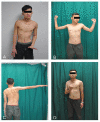Comparison between direct repair and human acellular nerve allografting during contralateral C7 transfer to the upper trunk for restoration of shoulder abduction and elbow flexion
- PMID: 31397352
- PMCID: PMC6788224
- DOI: 10.4103/1673-5374.262600
Comparison between direct repair and human acellular nerve allografting during contralateral C7 transfer to the upper trunk for restoration of shoulder abduction and elbow flexion
Abstract
Direct coaptation of contralateral C7 to the upper trunk could avoid the interposition of nerve grafts. We have successfully shortened the gap and graft lengths, and even achieved direct coaptation. However, direct repair can only be performed in some selected cases, and partial procedures still require autografts, which are the gold standard for repairing neurologic defects. As symptoms often occur after autografting, human acellular nerve allografts have been used to avoid concomitant symptoms. This study investigated the quality of shoulder abduction and elbow flexion following direct repair and acellular allografting to evaluate issues requiring attention for brachial plexus injury repair. Fifty-one brachial plexus injury patients in the surgical database were eligible for this retrospective study. Patients were divided into two groups according to different surgical methods. Direct repair was performed in 27 patients, while acellular nerve allografts were used to bridge the gap between the contralateral C7 nerve root and upper trunk in 24 patients. The length of the harvested contralateral C7 nerve root was measured intraoperatively. Deltoid and biceps muscle strength, and degrees of shoulder abduction and elbow flexion were examined according to the British Medical Research Council scoring system; meaningful recovery was defined as M3-M5. Lengths of anterior and posterior divisions of the contralateral C7 in the direct repair group were 7.64 ± 0.69 mm and 7.55 ± 0.69 mm, respectively, and in the acellular nerve allografts group were 6.46 ± 0.58 mm and 6.43 ± 0.59 mm, respectively. After a minimum of 4-year follow-up, meaningful recoveries of deltoid and biceps muscles in the direct repair group were 88.89% and 85.19%, respectively, while they were 70.83% and 66.67% in the acellular nerve allografts group. Time to C5/C6 reinnervation was shorter in the direct repair group compared with the acellular nerve allografts group. Direct repair facilitated the restoration of shoulder abduction and elbow flexion. Thus, if direct coaptation is not possible, use of acellular nerve allografts is a suitable option. This study was approved by the Medical Ethical Committee of the First Affiliated Hospital of Sun Yat-sen University, China (Application ID: [2017] 290) on November 14, 2017.
Keywords: accessary nerve; brachial plexus avulsion injury; contralateral C7 nerve root transfer; direct repair; elbow function; human acellular nerve allograft; nerve graft; nerve regeneration; nerve transfer; neural regeneration; phrenic nerve; shoulder function.
Conflict of interest statement
None
Figures





Similar articles
-
Analysis of human acellular nerve allograft combined with contralateral C7 nerve root transfer for restoration of shoulder abduction and elbow flexion in brachial plexus injury: a mean 4-year follow-up.J Neurosurg. 2019 Apr 26;132(6):1914-1924. doi: 10.3171/2019.2.JNS182620. Print 2020 Jun 1. J Neurosurg. 2019. PMID: 31026835
-
Contralateral C7 transfer combined with acellular nerve allografts seeded with differentiated adipose stem cells for repairing upper brachial plexus injury in rats.Neural Regen Res. 2019 Nov;14(11):1932-1940. doi: 10.4103/1673-5374.259626. Neural Regen Res. 2019. PMID: 31290451 Free PMC article.
-
[EFFECTIVENESS OF CONTRALATERAL C7 NERVE ROOT AND MULTIPLE NERVES TRANSFER FOR TREATMENT OF BRACHIAL PLEXUS ROOT AVULSION].Zhongguo Xiu Fu Chong Jian Wai Ke Za Zhi. 2014 Jun;28(6):737-40. Zhongguo Xiu Fu Chong Jian Wai Ke Za Zhi. 2014. PMID: 26466389 Chinese.
-
[Paralytic shoulder secondary to post-traumatic peripheral nerve lesions in the adult].Acta Orthop Belg. 1999 Mar;65(1):10-22. Acta Orthop Belg. 1999. PMID: 10216997 Review. French.
-
Gracilis free muscle transfer for restoration of function after complete brachial plexus avulsion.Neurosurg Focus. 2004 May 15;16(5):E8. doi: 10.3171/foc.2004.16.5.9. Neurosurg Focus. 2004. PMID: 15174828 Review.
Cited by
-
Clinical assessment in brachial plexus injury surgery: systematic review and proposal for integrated evaluation among different medical departments.Eur J Orthop Surg Traumatol. 2025 Apr 24;35(1):164. doi: 10.1007/s00590-025-04255-y. Eur J Orthop Surg Traumatol. 2025. PMID: 40272565
-
Plasticity of the Central Nervous System Involving Peripheral Nerve Transfer.Neural Plast. 2022 Mar 18;2022:5345269. doi: 10.1155/2022/5345269. eCollection 2022. Neural Plast. 2022. PMID: 35342394 Free PMC article. Review.
References
-
- Baltzer HL, Wagner ER, Kircher MF, Spinner RJ, Bishop AT, Shin AY. Evaluation of infraspinatus reinnervation and function following spinal accessory nerve to suprascapular nerve transfer in adult traumatic brachial plexus injuries. Microsurgery. 2017;37:365–370. - PubMed
-
- Bertelli JA, Ghizoni MF. Results of spinal accessory to suprascapular nerve transfer in 110 patients with complete palsy of the brachial plexus. J Neurosurg Spine. 2016;24:990–995. - PubMed
-
- Bhatia A, P Doshi, A Koul, V Shah, JM Brown, M Salama. Contralateral C-7 transfer: is direct repair really superior to grafting? Neurosurg Focus. 2017;43:E3. - PubMed
-
- Boyd KU, Nimigan AS, Mackinnon SE. Nerve reconstruction in the hand and upper extremity. Clin Plast Surg. 2011;38:643–660. - PubMed
-
- Chin B, Ramji M, Farrokhyar F, Bain JR. Efficient imaging: examining the value of ultrasound in the diagnosis of traumatic adult brachial plexus injuries: a systematic review. Neurosurgery. 2018;83:323–332. - PubMed
LinkOut - more resources
Full Text Sources
Research Materials
Miscellaneous

